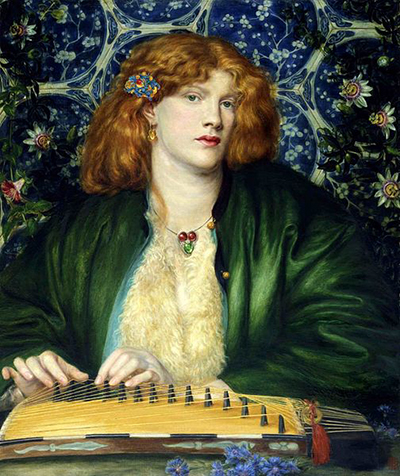The artwork is the work of Rossetti. It shows a musical woman. This is also the last great portrait of Fanny. The artist's mistress, Fanny Cornforth, was the model for this attractive image. The cornflower blossoms on the front mark her name, and the flowers of passion mark their fiery character.
However, the picture is more a hymn to beauty than a canvas. A pavilion is a private place for lovers, and Rossetti decorates it with exotic elements that fit into an honest love meeting. The tile combines the koto, which is a Japanese string instrument and a Chinese cherry motif with an Arabic form. Everything is presented with pre-Raphaelite meticulousness. Bower means that the private residence of a medieval woman was Rossetti's favorite. Medieval associations of this name are connected with the red hair, close-up composition and the brilliant color of the Venetian beauty of the Rossetti. Later, a heart-shaped pendant belonged to Jane Morris. Cornflowers can be a sign of the Fanny Cornforth model. Flowers of passion and whirlpools behind a figure can be read as symbols of passion or love relationships.
The painting is a vivid example of how DGR used the techniques of the Venetian Chincesento style as well as the formal and decorative features of the Japanese color prints Ukiyo-e in his paintings of the 1860s. This very sensual and decorative approach to his artwork was first seen in the remarkable work of the DGR of 1860, Bocca Baciata. The connection between this picture and the present work is underlined by the fact that the poem, which doubles the painting by Bocca Baciata from 1860, bears the traditional title "Song of the Bower." The profoundly erotic thought of the "bower" permeates the entire work of the DGR both textually and figuratively.
No matter how erotic the painting is, it is an almost abstract coloristic work, a sort of reverence to the Venetian and Japanese artisans whose paintings inspired DGR. The contrast of lush floral work and decorations with hexagonal tiles and blue background creates a work of art basis for the central drama of the picture, the play of green, red, gold, and blue. The whimsical, truly fantastic nature of the work is due to the purely decorative function of the Japanese. Koto emphasized that this does not exist in this environment and therefore, is not reproduced. The blue bower painting is of great significance. It is currently located at "the University of Birmingham," barber institute of fine arts.




